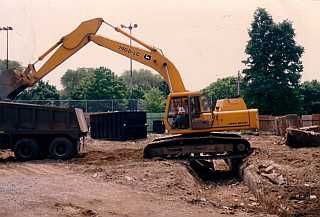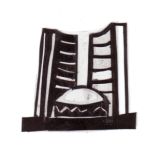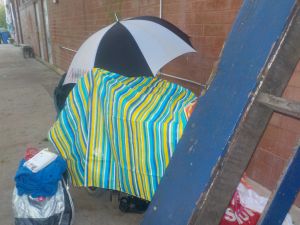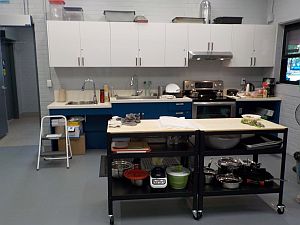Comments?
For the basics, see
- Website & Privacy Policies
- How To Get Involved
- The Role of the Park
Search options:
Department Site Map
Custodians:
Dufferin Grove Park September 2019 Newsletter (Week Two)
 Dufferin Rink reconstruction starting Feb.2020 |
This newsletter is put out by CELOS, the Centre for Local Research into Public Space. Since 2000, when this little organization began at Dufferin Grove Park, we’ve been doing what we call “theoretical and practical research” into what makes public spaces – like parks – more hospitable and more lively. We’ve been researching what works and what doesn’t, and we’ve documented a lot of what we’ve seen and done, in this newsletter and on our four websites.
EVENTS IN SEPTEMBER
Sunday Sept.15, 2019, 1 to 3 pm: Clay and Peter Theatre first Night of Dread brainstorming session
Tamara: “Clay and Paper Theatre invites you to help us build our private and collective fears! Join us for our 20th Annual Night of Dread creation and building process. We'll first discuss and brainstorm what’s the Fear of the Year for 2019? What are the possibilities? We’re not talking about our little fears (although they can be pretty overwhelming sometimes too). What’s in the air? What fears are people talking about? What are the collective fears we’re facing today as communities and citizens? What should we be afraid of? And why is fear so much fun???”
Thursday Sept.19, 6.30 p.m.: final public meeting about the rink/clubhouse renovation
At St.Wenceslaus Church, 496 Gladstone. Story p.6 – 7
Saturday Sept.21 and Sunday 22, all day: The Figment festival of Interactive Art
From the organizers: It's the festival’s 7th year in Toronto, and our 3rd year in Dufferin Grove. Do you have artwork, a performance or any project that uses the audience's participation to bring it to life? Do you love interactive art? If so, we'd love to showcase it at Figment! All artists receive an honorarium… We accept work from established artists, students, adults, youth, individuals and teams, in all disciplines and media (as long as it's interactive). More information here. We're also looking for *volunteers* of all ages - please contact us at torontovolunteers@figmentproject.org
Sept 28 2019: the 20th Native Child And Family Services Pow wow: RECONCILI-ACTION
On the soccer field. From the NCFS website: “All Dancers Welcome. Sunrise Ceremony 6AM - Registration 11AM - Grand Entry 12PM - Flag Retire 5PM . For vendor registration & more information please contact the Terri Jaffe, tjaffe@nativechild.org.” (Poster)
EDITORIAL: WHERE THE MONEY GOES
Many programs at this park (the adventure playground, basketball, extended shinny hockey, theatre and music, gardening) began as a community/CELOS/city staff partnerships. Food-related programs (snack bars, pizza days, Friday Night Supper, etc.) were a relatively small part of the overall social programming. The income from food (around $200,000 a year at the peak) covered the food costs and generated a surplus that could be used for the park as a whole. Since 2011, though, when the partnership ended and the city’s Recreation managers took over completely, the food programs seem to have become a much larger element of park staffing, requiring a very large subsidy from the city’s operating budget -- an anomaly not seen at any other park.
With the help of some Freedom of Information requests and a calculator, CELOS recently did the math for a sample year. We calculated that in 2018 the city spent $16,064 more on grocery supplies than they earned selling the food prepared with those supplies. On top of that, we calculated that the city spent another $202,529 on food-related staffing (part-time staff only, not counting full-time). But that doesn’t include staff benefits, wages of the food-related supervisory staff, admin staff (e.g. central financial services, food ordering etc.) These add between $50,000 and $100,000 to the subsidy total. The calculations are linked on the dufferinpark website.
So: in 2018, we calculated that the city’s operating-budget subsidy for Dufferin Grove’s Friday Night Suppers, park snack bars, pizza making, market bread baking, etc. – was more than $250,000. The calculations are posted here.

After weeks of unsuccessful efforts to find out more from city management, CELOS was told to contact Jane Arbour, Parks, Forestry and Recreation’s manager of Public Relations and Issues Management. We asked her whether our calculations match those of the Parks and Rec Finance staff, and if not, which details are different. She responded after a month, saying that actually the subsidy for staffing was $167,900. No more details accompanied this estimate.
The immediate question is: do the people in this neighbourhood really need their food subsidized? Most of them don’t.
But Parks and Rec says this subsidy is necessary: “the food programs at Dufferin Grove Park are well-loved by the community, and the Friday Night Suppers in particular are unique in Toronto. Part of our role as stewards of the city's parks and recreation spaces is to ensure that programs are staffed appropriately in order to support these community building activities.”
Meantime, other parks get very little. Women at Thorncliffe Park have to raise $1200 a month plus $200 insurance to pay rent on their shipping container café. The city owns a shipping container café at McCormick Park outright – so no rent payments. But there’s no staff support, so the McCormick Park café has been closed for a year. Time for some better (and fair) book-keeping!
LIVING IN THE PARK
Antonietta (Toni) Corrado is 71 years old, has two little dogs, uses an electric wheelchair, and has been living in Dufferin Grove Park since the beginning of August. When we were arranging a time for this newsletter interview, she sent an email from her cell phone: “l am here enjoying the view....l can look up at the trees and the sky... daytime planetarium.”
There followed three hours of talk with Toni, spread over three days, under the canopy of the trees, with the two little Shih Tzu dogs playing nearby. Sometimes children wandered up to say hi and pet the dogs, or a new park friend came by to offer a bag of grapes or an ice cream bar. In between, Toni had a lot of stories. She grew up as part of an Italian immigrant community in Windsor. As a young woman she worked in a Windsor bar and got to know some of the legendary musicians who performed there (Duke Ellington, Tony Bennett, Sammy Davis Junior). Then for many years she was a flight attendant who flew all over the world and met all sorts of people. So she has some lively tales of those adventures.
In 1990 Toni had a fall during work that began a different story. The injury had consequences which worsened over time. “The path to disability is a long one,” Toni says, “and along the way you can’t see where it’s going.” In her case, she sold her house to buy a condo, for wheelchair access. But as other problems came up, she lost the condo and eventually went back and forth between stays in hospital and a couple of shelters. She ended up at the Sistering 24-hour women’s drop-in on Bloor at Dovercourt, and that was also, she said, the end of the shelter system for her.
Sistering and other city emergency shelters and drop-ins
The Sistering drop-in is in some trouble now, as is evident to anyone walking by that stretch of Bloor. Toni says it was a dangerous place for her and for other residents because of the violence that’s a daily part of the experience inside. That’s not so different from any other city emergency shelter or drop-in. In an Aug 29 2019 article in Spacing Magazine, John Clapp writes: “From June, 2018, to April, 2019, I was one of the 2,000 applicants [for affordable housing] staying in a Toronto homeless shelter. While there, I observed how shelter policies and staff conduct also contribute to delays in processing homeless applicants. Shelter clients can be discharged by staff at any time during the day or night, and in all types of weather for any number of real or perceived infractions, and often for the most arbitrary of reasons. Homeless shelters are overcrowded and rife with bullying, which increases the likelihood that conflicts will occur and results in one or more clients being discharged. I have even seen some staff members instigate conflicts between clients.”
Toni says she’s done with shelters: “I’d rather live in an igloo in the park than go back there.”
The city auditor’s report
The culture of shelters is a bit like prisons. People need a home to live in. There are major blocks, though. From a critical report released in June 2019 by Beverly Romeo-Beehler, the city’s auditor:
"1,400 housing units sit empty on average across the entire social housing system. The vacancy rate at TCHC is 2.29 per cent; more than double Toronto’s average vacancy rate. Bachelor units have formed a large proportion of vacancies over the last several years, while there are thousands of seniors on the list who have never received an offer – there are 200 bachelor units in seniors-designated buildings sitting vacant." (Source)
And from John Clapp’s article in Spacing:
“Adding insult to injury, not-for-profit housing providers still receive the subsidized portion of the rent from the City of Toronto even for vacant units, costing taxpayers $7 million in unnecessary rent subsidy payments in 2018.”
A gift to the park
Toni’s presence while living in the park has made an interesting difference. People overcome their shyness and talk to her, and enjoy her friendliness. She’s a kind of park welcomer. People also talk to each other more, maybe while walking their dogs in the park, or on Erella Gagnon’s dufferingrovefriends listserv – for instance, about where Toni (or anyone) might find good rental housing. Toni gives the gift of her enjoyment – telling people that the freedom of living in the park is often fun, that even her asthma has improved hugely since she spends so much time outdoors. She watches the moon rise. She knows the life of the park at all hours. If there was a little apartment in the park where she could live, Toni would make a terrific park steward.
But there isn’t such a little park apartment, and the cold weather is coming. Toni has had some visits from the city’s Streets to Homes staff. They’ve helped her fill out some forms, and encouraged her to get new I.D. documents to replace some that were stolen. Hopefully they’ll be able to find her a small accessible apartment of her own, that she can pay for with her pension.

No clubhouse
Meantime, Toni says the cold is not a problem for her. Heavy rain is no fun, though. Recently she spent a rainy night next to the rinkhouse, under an umbrella and a plastic tablecloth. When the rinkhouse was still a community clubhouse, she would have been invited to take shelter for the night in the warm, dry entry hall. We asked the city on her behalf, but city management wrote back: “The facility is not available to members of the public after hours.” Keeping the rinkhouse nice and dry and empty of a senior in a wheelchair is not like having a community clubhouse. If you want to contact the Rec supervisor about this: Donna.Densmore@toronto.ca
Clay and Paper Theatre news: The 5 steps to Night of Dread (starts Sunday Sept.15)
1. Invite community to help Clay and Paper Theatre develop the Fear of Year.
2. Build the Fear of the Year image and create a theatrical scenario for Night of Dread.
3. Parade and animate the Fear of the Year on October 26th.
4. Mock and laugh at the Fear of the Year. Then - BURN IT in the bonfire!
5. Feel energized, courageous and inspired. Tackle MORE fears!
From Tamara: There will be snacks, coffee and tea! Kraft paper and clay will be available to help facilitate discussion. The Dufferin Grove Park Clubhouse is also wheelchair accessible.
We are launching our GoFundMe this week. We are also holding our community consultation meeting for sure and will be popping up at the Farmers’ Market to talk with folks about their fears for 2019.
From the Build a Better Bloor Dufferin (BBBD) Coalition:
A possible City Council resolution will let the high rise project go ahead before the OMB/LPAT inquiry is due in October. Really? The BBBD website tells the story: here.
Macgregor Park and Field House renovation

new kitchen
This $700,000 renovation is now complete. The wading pool was replaced by a splash pad (meaning no more staff) and the building has a new main entrance (at the back) plus a new kitchen. The laneway just north of the park has been renamed Kristen Fahrig Lane, for the much-missed Botanicus Arts founder. Kristen’s ardent wish in her final days was that the archway she designed would be erected. Her friends and family have raised the money for it, Parks management has approved it, and the installation will be sometime in the fall.
In the meantime, the renovated building was open for three Saturday evenings in August (for a park supper). In the fall, it will be used as a replacement location for the McCormick after-school program while McCormick Centre is closed for its $3 million renovation.
Dufferin Grove gardening
The park gardens are down to two volunteers – more are needed. There are lots of beds to work on, including a kale garden, accessible raised beds, a green roof, vegetable and flower and native species gardens. Staff often prepare snacks for the volunteers. Ask the staff, or ask Skylar (the volunteer gardener), or come by and take a look on a Wednesday or Sunday afternoon.
Disagreements about the $4.5 million Northwest Corner “revitalization project” -- Pro and Con
Pro: --The strongest supporters of the project, including the replacement of the current east-west rink pads with north-south rink pads and the reorientation of the basketball court have been skateboarders, bike polo participants, the farmers’ market board, and some of the long-time shinny permit holders. Representatives of each group were part of the Community Resource Group set up by LURA, the city’s public engagement consultant.
.The city’s capital project construction schedule for Dufferin Grove is linked here
Con: trees in the park
One of the elements of the plan is the removal of trees near the rink to make room for a long path. There is some unhappiness about the destruction of the trees, despite the plan to plant more new trees.
Leena Raudvee: “The new row of uniform replacement trees look lovely on the plan but will not provide the shade, the habitat, the environmental benefits of the mature trees for many many years.”
Con: environmental damage contributing to climate change.
Belinda Cole: “Demolishing the rinks to replace them with new ones poses a huge problem for me. I'm guessing lots of us saw the Anthropocene exhibit at the AGO. The city insists we tear out, then replace 2 concrete rinks that are apparently working fine, the replacement based on an assumed lifespan. Isn't this is a pivotal Anthropocene question in our own back (park)? I can’t help wondering what the effects of the proposed rink demolition and replacement look like right here. The energy to tear up cement surfaces, move it, add it to landfill, mine and transport the materials needed to make it, produce the greenhouse gases and use huge amounts of water to make more concrete, transport that concrete here….I can’t help wondering when the whole community gets to have an open vote about this project.”
Con: The Dufferin Grove Park Northwest Corner Revitalization – A Critical look (CELOS) (Linked here and available in paper copies at the park.) From the booklet: The reasons given by the engineering consultant for rink slab demolition are (1) the shape of the rink’s corners and (2) the city standards for dimensions of new rinks (note: many existing rinks including indoor arenas do not have the standard measurements).
The FOI response also included an internal email chain, in which the Parks general supervisor says that Parks doesn't have to give the public any evidence of problems with the rink slabs. “City Standards should be enough of a reason even if they don’t like it.”
Sept.4 (small group) Northwest Corner reno meeting excerpts from the dufferingrovefriends listserv
Ellen Manney: “There is a whole section in the plans on energy efficiencies, including a green roof planted with pollinators on the new zamboni garage and temporary water storage on the roof of the clubhouse. The plantings will be native, with an emphasis on pollinators. There will be permeable paving, plugs, hoses, bike racks, benches with backs, chairs etc. in the plaza.”
Andrea Holtslander: “With the help of others in the community Skylar Hill-Jackson has collected 800 signatures against Option 2 of the park reno, which moves the rinks to a north-south layout. This layout change will be disruptive and environmentally costly. The rinks do not need to be replaced, as indicated in the Freedom of Information report here. The petition is also online.
DTAH, the design consultant, spoke about recycling the concrete from the rink. But recycling doesn't factor in the massive amounts of heat and water it takes to make new concrete, as well as all the energy used in construction.
Regarding trees, changes were made to an earlier plan to the rinks, and now the trees along the Gladstone path will no longer will be cut down. The large linden tree southwest of the rink house will stay. The two big cherry trees will come down. The one inside the Children's Garden is dying. The other one is in the way of the new rink. Five trees west of the rink house will be removed to allow for grading of the site. In total, nine trees will be removed and 18 others will be planted.
One petition item has been addressed - the zamboni "snow mountains" will remain for children to play on.
At the meeting (off record) Peter Didiano (Capital Projects, Parks and Rec) said this project is for the 3000 or 4000 people coming in to the community. However, the project adds little in the way of capacity. It solves some accessibility issues but only for a fraction of the park. It looks lovely, but seems more like an expensive face lift that doesn't take into account other park needs: accessibility throughout, fixing up the fieldhouse bathrooms, removing the slippery coating from the wading pool, playground plumbing issues, and what about space for Clay and Paper Theatre?"
The final public meeting will be:
Thursday, Sept. 19, St. Wenceslaus Church,
496 Gladstone Ave. 6:30 - 9:30 pm
Editor: Jutta Mason
Illustrations: Jane LowBeer
www. dufferinpark.ca, celos.ca, cityrinks.ca, publicbakeovens.ca




 Printer friendly version
Printer friendly version